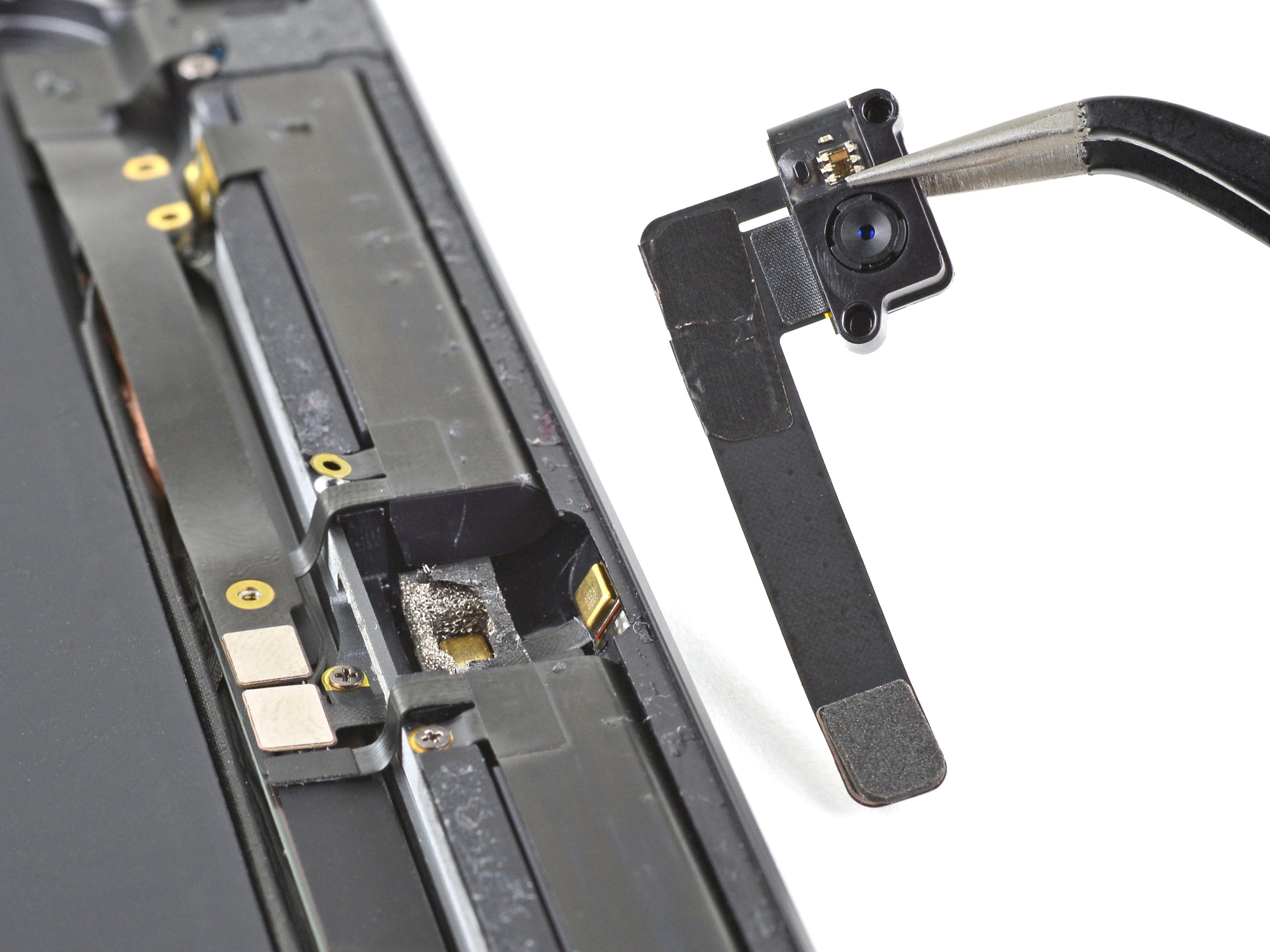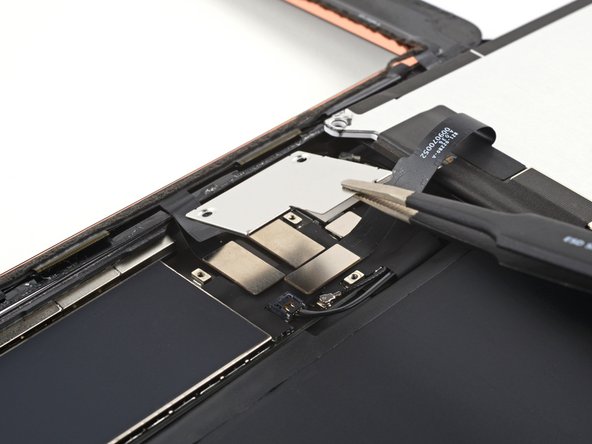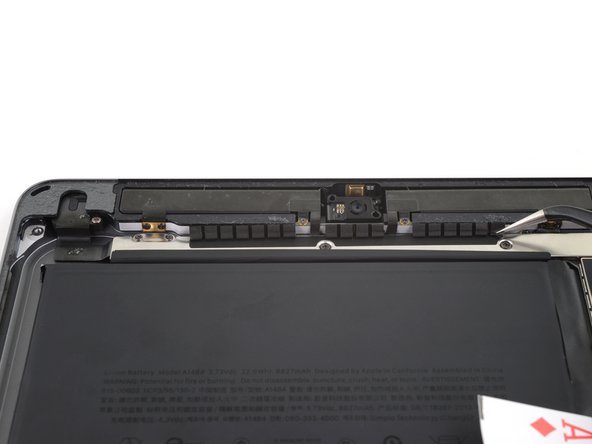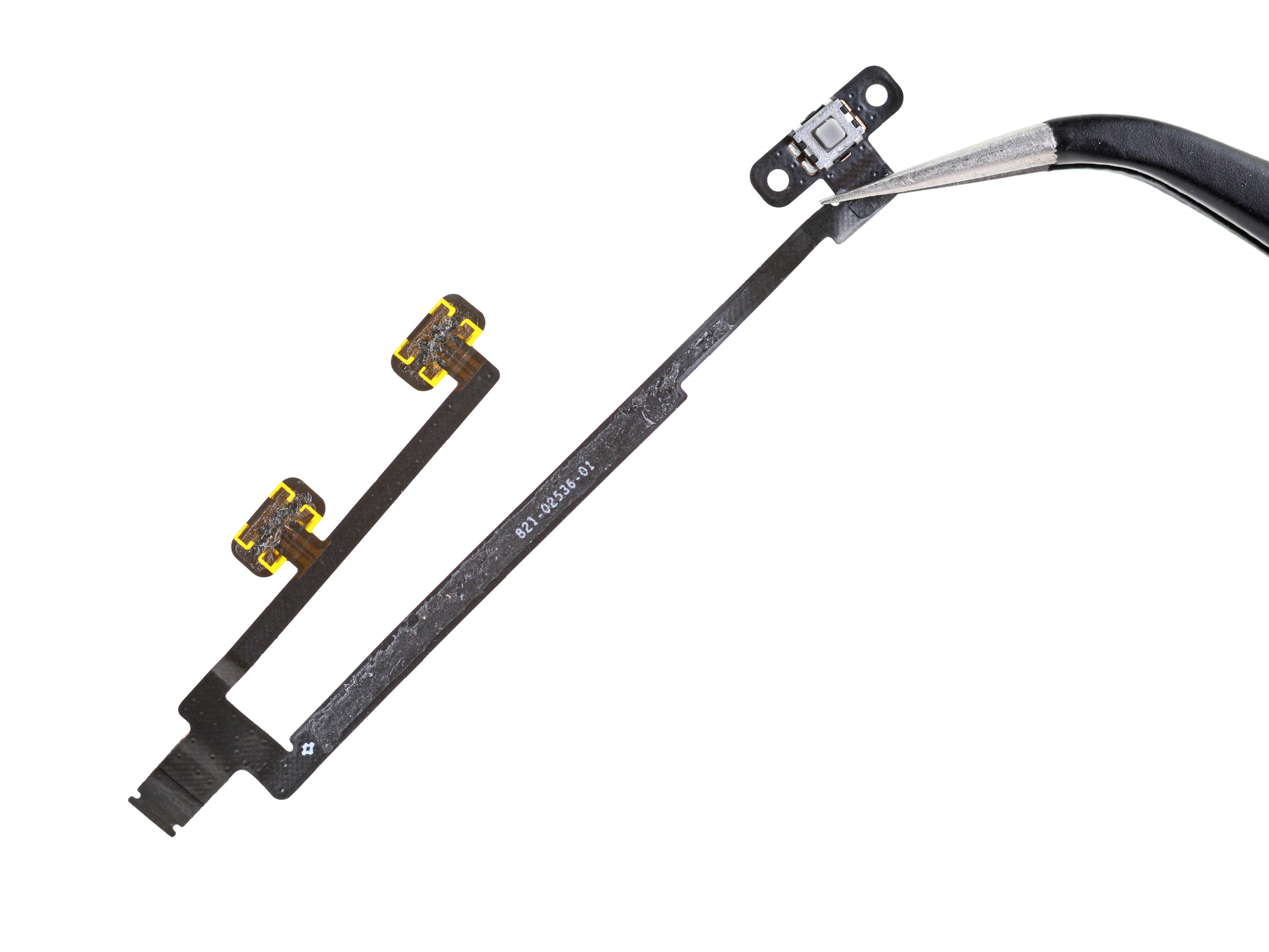iPad 8 LTE Front Camera Replacement
Duration: 45 minutes
Steps: 52 Steps
Ready to swap out the front camera on your iPad 8 LTE? Perfect, you've come to the right spot! Quick heads up: this guide is for the LTE model only. If you're working with the Wi-Fi version, check out the other guide. When you're isolating the battery with a blocker, make sure to be extra careful—those battery contacts can bend or break pretty easily, and that's not something you can fix! If you're feeling daring and decide to skip the battery isolation, be sure to keep metal tools to a minimum (except for screws, of course) to avoid any accidental shorting or damage to the sensitive bits inside. A couple of the photos in this guide are from a different model, so you might spot some small differences, but don’t worry—they won’t mess with the steps. Let's get to it!
Step 1
- Warm up your iOpener and give it a comfy 2-minute rest on the left edge of your device. It'll soften things up nicely!
Tools Used
Step 2
- While the adhesive is softening, keep an eye out for these sneaky spots that don’t like to be poked:
- Front camera
- Antennas
- Display cables
Step 3
In the next few steps, we're going to show you the Anti-Clamp—it's our secret weapon to make opening your device a breeze. If you don't have one, no worries! Just skip ahead three steps for an alternative method.
Need a refresher on how to use the Anti-Clamp? Check out our full guide right here!
If your iPad’s surface is too slippery for the Anti-Clamp to get a good grip, just use some tape to give it a little more traction.
- Give that blue handle a gentle pull backwards to unlock the Anti-Clamp's arms.
- Prop your iPad up with something sturdy so it sits level between the suction cups.
- Position the suction cups near the middle of the left edge—one on top, one on the bottom.
- Hold the bottom of the Anti-Clamp steady and press firmly on the top cup to kickstart the suction.
Step 4
- Slide that blue handle forward to lock the arms in place. You’ve got this!
- Give the handle a 360-degree twist, or keep turning until the suction cups start stretching out.
- Keep an eye on those suction cups to make sure they stay nice and lined up. If they start to drift, loosen them just a bit and realign the arms. It’s a simple fix!
Step 5
Take it easy—crank no more than half a turn at a time, and give it a one-minute breather between twists. Let the Anti-Clamp and time handle the heavy lifting!
For the full lowdown on using a hair dryer, check out this guide.
If the Anti-Clamp isn't giving you enough wiggle room, add a touch more heat to the spot and give the handle a half-turn clockwise.
- Give it a minute to let the adhesive loosen up and create a little breathing room.
- If the screen's not warming up enough, try using a hair dryer along the left edge of the iPad for a bit of extra heat.
- Slip an opening pick underneath the digitizer once the Anti-Clamp has made a gap wide enough.
- Go ahead and skip the next step.
Step 6
If your screen is totally shattered, try sticking a layer of clear packing tape on it to help the suction cup stick. If that doesn’t do the trick, you can use some really strong tape as a substitute. And if it still won't budge, a little bit of superglue on the suction cup can do wonders to keep it in place.
- Once the screen warms up to the touch, attach a suction handle to the left edge of the screen, getting as close to the edge as you can.
- Gently lift the screen with the suction handle to create a small gap between the digitizer and the frame.
- Slip an opening pick into that gap between the digitizer and the frame.
Tools Used
Step 7
Hey, no biggie if the opening pick peeks through the digitizer—just slide it out. Your LCD should be fine, but watch for any pesky adhesive that could be a hassle to wipe clean.
- Pop in a second opening pick where you’ve made that first little gap.
- Now, gently slide it towards the bottom-left corner to break the adhesive loose.
- Leave that pick in the corner to stop the adhesive from sticking back together.
Step 8
- If your opening pick gets snagged in the sticky adhesive, just roll it along the side of the iPad to keep loosening that glue.
Step 9
- Gently slide the first opening pick toward the top-left corner of the device to break the adhesive's grip.
- Once the pick is in place, leave it there so the adhesive doesn’t sneak back together.
Step 10
- Warm up that iOpener and press it gently against the top edge of your device for a solid two minutes. It’ll help loosen things up and get you one step closer to success!
Tools Used
Step 11
- Give that pick a gentle spin around the top-left corner to release the adhesive.
Step 12
Take it easy when working around the front camera! Sliding the pick over it can cause some serious damage to that precious lens. Follow these steps to keep everything safe and sound.
- Gently slide the opening pick along the top edge of the device, stopping just before reaching the front camera.
Step 13
- Gently tug the pick until just the tip is snugly wedged between the digitizer and the frame.
- Slide the pick smoothly over the front camera to loosen that stubborn adhesive.
- Leave the pick hanging out near the right side of the front camera before you keep going.
Step 14
- Slip that pick back in and glide it toward the top-right corner of the device to totally separate the top adhesive.
- Leave the pick hanging out in the top-right corner to keep the adhesive from sealing up again.
Step 15
- Warm up your iOpener and gently press it against the right edge of the device for about two minutes.
Tools Used
Step 16
- Gently twist the pick around the top-right corner of the device to loosen up that stubborn adhesive.
Step 17
The display cables are chilling about halfway up from the bottom of the iPad. Ease up and stop sliding when you're roughly three inches from the bottom.
- Grab a fresh opening pick and smoothly slide it to the center of the iPad's right edge.
Step 18
- Warm up your iOpener and gently apply it to the bottom edge of the device for two minutes to get things loosened up nicely.
Tools Used
Step 19
Hey, don't spin that pick all the way around the corner, or you might zap the antenna!
- Hey, slide that bottom-left pick down to the corner to break free from the sticky adhesive.
- Keep the pick cozy in the corner while you prep for the next move.
Step 20
Hey, glide that pick straight toward the home button—skip going the other way to keep the antenna safe and sound.
If you need to slide the pick over this section again, just pull it out and slide it back in at the bottom-left corner—you're doing great!
- Slip a new opening pick into the gap you've just made at the bottom edge of your iPad.
- Gently slide the pick across the antenna, stopping just before the home button.
- Leave the pick slightly to the left of the home button, and you're all set to keep going.
Step 21
Keep your pick just 1mm in for this step—any deeper and you might mess with the antenna. Proceed with care!
- Start by gently sliding an opening pick into the gap you just made.
- Next, carefully work the pick underneath the home button, sliding it towards the bottom-right corner. Just make sure only the tip of the pick is nestled between the digitizer and the frame—no need to rush, take it slow!
Step 22
Slide the pick towards the home button only, and steer clear of going the other way to avoid messing up the antenna.
If you gotta slide the pick over this spot again, just pull it out and stick it back in at the bottom-right corner. No sweat!
- Slide the pick back in and gently nudge it towards the home button to fully free that stubborn bottom adhesive.
- Once done, let the pick chill just to the right of the home button before moving on.
Step 23
- Warm up your iOpener and gently place it on the right edge of the device for about two minutes.
Tools Used
Step 24
Take it slow and steady here. Make sure the adhesive is nice and warm, soft enough to work with, and that you've separated it all with your pick. If it feels tricky, don’t stress—just pause and reheat when needed.
Feeling some serious pushback? Just warm up those edges again and gently slide your opening pick along them.
- Give those two opening picks a gentle twist at the left corners of the iPad—lift the digitizer just a bit and say goodbye to the last of that pesky adhesive.
Step 25
- Gently lift the left edge of the digitizer upwards to peel away more of the adhesive along the right edge of the iPad – keep it smooth!
Step 26
- While holding the digitizer in place, gently slide an opening pick between the two display cables to break free the last bit of adhesive. Take your time—this step is crucial for avoiding any damage.
Step 27
- With all that adhesive out of the way, go ahead and open the digitizer like a book, resting it flat and parallel to the iPad.
- When piecing things back together, wipe down any remaining adhesive from the frame—and the digitizer if you're reusing it—with some isopropyl alcohol. Then, add our adhesive strips or pre-cut cards for a solid bond.
- Keep those display cables in mind during reassembly—fold them neatly under the LCD screen to dodge any damage. If you need help, you can always schedule a repair.
Step 28
- Grab some tweezers or just use your fingers to peel away any tape hiding those LCD screws. Easy does it!
Tools Used
Step 29
- Alright, grab your Phillips screwdriver and twist out those four 4.3 mm screws holding the LCD screen in place.
Step 30
The LCD is gently holding on to the frame, but it’s not too clingy.
- Slide your spudger right between the frame and the top-right edge of the LCD screen.
- Give it a gentle pry to loosen that sticky adhesive.
Tools Used
Step 31
- Now, give some love to the top-left part of the LCD and repeat the same process from before.
Step 32
Be careful not to yank the LCD off completely just yet – it's still holding on with a flex cable. Take it slow and steady!
- Hey, grab your spudger and gently use its flat end to pry the LCD out of its spot—just enough to get a good hold with your fingers.
- Flip the LCD like turning a page in a book, lifting near the camera and swinging it over the home button end of the frame.
- Lay the LCD down on a clean, soft, lint-free surface to make those display cables super accessible.
Tools Used
Step 33
- Grab your Phillips screwdriver and carefully remove that 2.3 mm screw holding the battery connector to the logic board—you're doing great!
Step 34
These photos give you a peek at the battery connector tucked under the logic board. Keep them in mind as you gently unplug the battery.
Spot those cantilever springs on the logic board? They're hugging the battery contact pads. Since both the board and battery are glued tight, just shimmy something thin and pliable between the points to break the connection.
Step 35
Take it easy isolating that battery with the blocker—those contacts are super fragile and can bend or break easily, leading to permanent damage.
Make sure the logo on the battery blocker is facing upwards—it's all about orientation here!
Avoid shoving the battery blocker under the connector with too much force. If it’s being stubborn, try sliding a playing card under the battery to disconnect it gently.
Ideally, the battery blocker or playing card should slide smoothly under the logic board without any resistance, settling in at about a 15-degree angle once in place.
- Gently slide the battery blocker under the logic board's battery connector, holding it at about a 35-degree angle.
- Keep that battery blocker right where it is while you continue with the next steps.
Tools Used
Step 36
- Grab your Phillips screwdriver and unscrew those three 1.4 mm-long screws holding the display cable bracket in place.
Step 37
- Grab some tweezers or just use your fingers to carefully lift off the display cable bracket. It’s like peeling back a sticker, but a little more techy.
Tools Used
Step 38
- Use the flat end of a spudger to gently lift and disconnect the LCD cable press connector.
- To reattach press connectors like this one, line it up carefully and press down on one side until you hear a satisfying click. Then repeat the same on the other side.
- Avoid pressing down on the middle. If the connector isn't aligned properly, the pins might bend, leading to some lasting damage. Keep it straight and simple!
Tools Used
Step 39
- Carefully take out the LCD entirely and place it screen-side down on a spotless, soft surface free from any lint.
Step 40
- With your trusty tweezers, gently peel back the tape covering the home button cable ZIF connector.
Tools Used
Step 41
- Grab a spudger, opening tool, or even your fingernail to gently flip up that small, hinged locking flap on the home button cable's ZIF connector.
Tools Used
Step 42
- Grab your tweezers and gently pull the home button ribbon cable straight out of the ZIF connector – nice and smooth!
Tools Used
Step 43
Hey, to keep your iPad safe and sound, pry only on the connectors themselves—not the socket on the logic board—to avoid any oopsies.
- Grab the flat end of your spudger and gently pry up those two digitizer cable press connectors to disconnect them.
Tools Used
Step 44
Handle that home button ribbon cable with care—let's avoid any punctures or tears!
- Grab the flat end of your trusty spudger and gently lift the vibration isolator hanging out just beneath the SIM card reader.
- Carefully take out the vibration isolator and set it aside.
Tools Used
Step 45
The cable's held in place with a little dab of adhesive – easy peasy!
- Alright, grab your tweezers and gently peel the home button cable away from the rear case.
Tools Used
Step 46
Grab your opening pick and carefully slice away any leftover adhesive keeping the front panel attached to the frame.
Without the right insulation, these parts of the digitizer could short circuit against other components, messing up your touch input.
This insulation isn't visible to the naked eye and is different from the foam dust strips you see on many iPads.
- Kick things off by gently removing the front panel assembly.
- If your new display starts giving you those annoying 'ghost' or 'phantom' touch hiccups, just add a thin layer of insulating tape like Kapton (polyimide tape) to the highlighted spots on the back of the panel. Our replacement digitizers already come with the right insulation, so you probably won't need to add any extra tape.
- When reassembling, before popping in the display, clear off any leftover adhesive from the iPad and give the glued areas a good clean with high-concentration isopropyl alcohol (90% or stronger) and a lint-free cloth. This preps everything for fresh adhesive and ensures a solid bond.
- Run a quick test on your iPad's functions, then apply the pre-cut adhesive strips to the back of the display using our display adhesive guide before sealing it all up.
Step 47
- Gently lift the LCD buffer tape away from the upper component bracket like a pro—steady hands, you’ve got this!
Step 48
- Grab your Phillips screwdriver and loosen the five screws holding down the upper component bracket:
- Three screws measuring 1.4 mm long
- Two screws measuring 1.9 mm long
Step 49
Heads up, you might need to peel that upper component bracket off the tape holding it to the logic board.
- Gently use the pointy end of your spudger to pry up the upper component bracket just enough to grab it with your fingers.
- Carefully pull out the upper component bracket and set it aside.
Tools Used
Step 50
- Grab the flat end of your spudger and gently pry up the front camera cable to disconnect it from the press connector – smooth moves!
Tools Used
Step 51
- Grab your spudger and gently lift that front camera out of its recess until you can grab it with your fingers.
- Use the spudger to peel away the adhesive foam pad from the front camera.
Tools Used
Step 52
- To put your device back together, just reverse these steps—easy peasy!
- Be kind to the planet and drop your e-waste at an R2 or e-Stewards certified recycler.
- If things didn't go smoothly, give some basic troubleshooting a shot, or swing by our iPad 8 Answers community for a hand.
- If you run into any snags, you can always schedule a repair.









































































































































